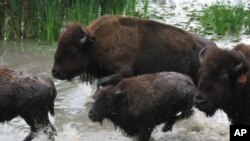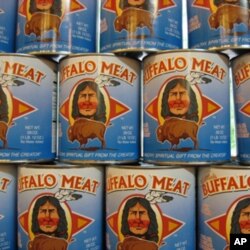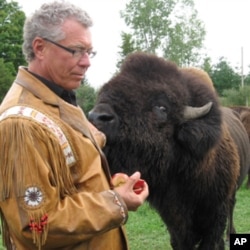On a chilly autumn day in Fort Wayne, Indiana, customers inside the Three Rivers Café and co-op are lining up for a tasty meal of bison meat.
Growing numbers of Americans are enjoying bison because it is considered more healthful than other meats. It is 40 percent higher in protein than beef, has more iron and potassium than pork, and is 97 percent fat free. It's being used in everything from sausages to spaghetti sauce, as well as burgers, steaks and stew.
In fact, it's so popular that Adalyn Parker, the meat buyer for the co-op, says there's a problem.
“In a week, we sell close to 20 packages, which is a pretty high number for a place like this. It's increasing, so that our supplier is out of stock until late November, because the demand is getting so high for it.”
Three Rivers isn't the only retailer facing a shortage. All across the country, groceries and restaurants are running out of bison.
That's a great problem to have, says Del-Vonna Feldbauer, who manages Wild Winds Buffalo Preserve, in Fremont, Indiana.“This was kind of a surprise for all of us. No one really thought we'd be out of meat.”
Over 30 million bison once roamed the North American plains, providing Native tribes and later, European settlers, with meat and hides. However, by the late 19th century, the animals had been hunted nearly to extinction. Over the past few decades their numbers have rebounded, in large part due to conservation and a savvy food marketing campaign.
John Trippy, a retired physician who owns the Wild Winds Buffalo Preserve, believes the bison industry owes much of its success to the National Bison Association's 2001 advertising campaign to promote the meat.
“They started doing research on the nutritional value and taste and they got chefs involved," Trippy says. "That awareness is really what kicked off the public's interest in ‘Oh my gosh, we have an alternative to beef or to pork or to chicken.’ In New York City, they were calling it the sweet meat because it has a sweet taste to it. It's almost addictive, honestly, after you start eating it.”
Bison is about twice as expensive as other meats. Still, top producers say they could easily increase sales by 30 percent, if they had the meat to sell.
A key reason supply for bison lags behind demand is because it takes bison a full year longer to have offspring than cattle. It also those bison calves a full year longer than young cattle to gain enough weight to be ready for market. In addition, many ranchers are finding it more profitable to hold on to heifers for breeding rather than slaughter.
And there simply aren't enough bison ranches to compete head-to-head with cattle as an alternative source of meat.
“Today we have about 500,000 bison in the country," says Trippy. "We slaughter 250,000 cattle every day, so it's a little, minute part of the market.”
The challenge now is to keep up with the demand, so they can hold onto their small-but-growing share of the market.
The National Bison Association has launched a new campaign which encourages ranchers to increase their bison herds. The group also hopes to persuade some cattlemen to switch to bison, meeting with them to point out that the animals are cheaper to feed and require almost no maintenance.
If the recruitment effort is as successful as the 2001 marketing campaign, America's bison supply could be back on track by 2014.










